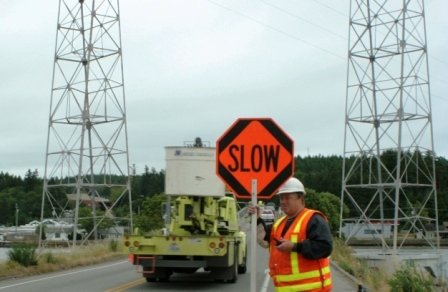PJ Callahan, KP News
While recent roadwork on the Purdy Bridge only restricted traffic for one six-hour period, the future of the historic bridge is unknown. Drivers on State Route 302 experienced short delays as traffic was limited to one way on June 22 from 4 a.m. to 9 a.m. The work, originally scheduled until 3 p.m., was completed in half the time, which avoided more serious delays. A worker directs traffic during the June 22 bridge inspection work.Photo by Karina Whitmarsh
A worker directs traffic during the June 22 bridge inspection work.Photo by Karina Whitmarsh
“Traffic was starting to build right around 9 a.m., but the crews were able to open it back up and traffic dissipated,” said Emily Pace with Washington State Department of Transportation Communications.
The work allowed for guardrail replacement after an oversized truck struck the guardrail earlier in the year. The WSDOT also took advantage of the closure to perform a biennial inspection of the span. The last inspection was held on July 20, 2006.
According to Chris Keegan, Olympic region operations engineer, “There was no change from the last inspection that was done in 2006.”
“The bridge is both functionally obsolete (the roadway is only 20 feet wide from curb to curb) and structurally deficient with a sufficiency rating of 23.45. It is structurally deficient for design and condition. The bridge was designed to carry lighter loads back in 1936 than we design for today,” he said. “The piers out in the water have some condition problems. In the tidal zone, the concrete has been alternately soaked with salt water and then exposed to the air for over 72 years. This has allowed salt water and chlorides to get through the concrete and into the outer layer of steel reinforcing. The concrete over the rusty reinforcing has broken off and some of the reinforcing bars have rusted away. The inspection has a repair listed to clean off these two piers and then encase the damaged concrete with new concrete and epoxy coated reinforcing.”
The historic Purdy Bridge spans the strait between Henderson Bay and Burley Lagoon. This stretch of highway averages 12,000 vehicles daily, WSDOT statistics show According to the WSDOT Website, the bridge is a reinforced concrete box girder-style bridge. At 550 feet long, it was considered the longest bridge of its kind when it was built. This type of bridge was known for its low cost and simple, graceful design. The bridge is on the National Register of Historic Places. Given historic nature, dederal requirements must be completed before rehabilitating or removing the bridge.
When asked whether repairs might be made soon, Keegan said, “This work is beyond what our maintenance personnel can do. It is having to compete with other bridge repair work throughout the state and is not currently a funded project. There are more bridges with a greater need for repair in Washington than the Purdy Spit Bridge. The bridge is old, tired and obsolete, but still has a lot of life in it. Even with its current condition, it will give many more years of service.”
WSDOT updated a 1993 SR-302 Corridor Study in February 2008. The study was commissioned by the Washington State Legislature as part of the Transportation Partnership Funding Package (9.5 percent gas tax). The report includes corridor alternatives meant to offer “all reasonable options for travel between SR-16 and SR-3.” Several alternatives would affect the current Purdy Bridge, including replacing the existing bridge or building a new one parallel to the existing bridge and widening the roadway across the spit. Other options would move the corridor farther north.
According to the report, “All of the potential bridge crossing locations of the Burley Lagoon would require long span lengths and high columns due to the crossing distance and steep grades on the west side approaches. This would result in high costs for any new bridge. Requirements for bridge piers in the water would also be challenging to permit due to potential impacts to aquatic resources.” One of the next steps, according to WSDOT, will be to narrow the alternatives based on fatal flaws, unreasonable costs and unreasonable impacts, such as extremely high impacts to wetlands and marine areas or businesses and homes.
The study will move forward using the federal National Environmental Policy Act process. As part of this effort, WSDOT will soon convene an advisory committee of local residents representing a broad range of community interests. For more information about this group and the SR-302 Corridor Study, visit www.wsdot.wa.gov/projects/SR302/NewCorridor.
UNDERWRITTEN BY THE FUND FOR NONPROFIT NEWS (NEWSMATCH) AT THE MIAMI FOUNDATION, THE ANGEL GUILD, ADVERTISERS, DONORS AND PEOPLE WHO SUPPORT INDEPENDENT, NONPROFIT LOCAL NEWS